Types of Small Flying Bugs In House (With Pictures) – Identification Guide
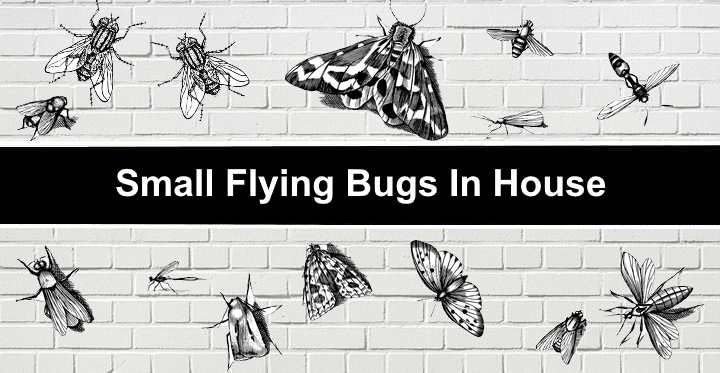
Small flying bugs can be an extreme nuisance in homes. Fruit flies and fungus gnats are the most common flying house pests that most people can identify. However, annoying flying pests in houses also include houseflies, drain flies, cluster flies, whiteflies, and pantry moths.
Identifying types of small flying bugs in the house is the first step to getting rid of them. Typically, flying pests are usually active around a food source or nest. For example, although they look similar, the difference between fungus gnats and fruit flies is that fruit flies tend to only be around decaying fruit or garbage, whereas black gnats infest houseplants.
In this article, you will find out about small flying bugs in the house that are not fruit flies. A practical identification guide will help you recognize the type of disgusting bugs flying around your home. In addition, you will get tips on eradicating flying house bugs for good.
Identifying Small Flying Bugs
To identify small bugs flying in your home, look at their behavior, shape, and where they tend to be. Try to find out what attracts the annoying flies — odors, dampness, poor sanitation, or heat. Some flies are typically found in the kitchen near drains, garbage cans, or rotten food.
Then look at the color of the flying bugs to identify them. For example, fruit flies are dark brown, whereas gnats are black. However, drain flies are larger, moth-like, gray insects and are common in kitchens. Black houseflies tend to fly around erratically and are typically found on windows.
Small Black Flying Bugs in the House That Are Not Fruit Flies
Many people assume that tiny flying bugs are fruit flies. However, if the little flying bug is black, not brown, then the chances are that the bug is a fungus gnat, not a fruit fly. There are also other kinds of flying household bugs that are not fruit flies. Here are a few.
Gnats – Tiny Flying Bugs in the House That Look Like Black Dots
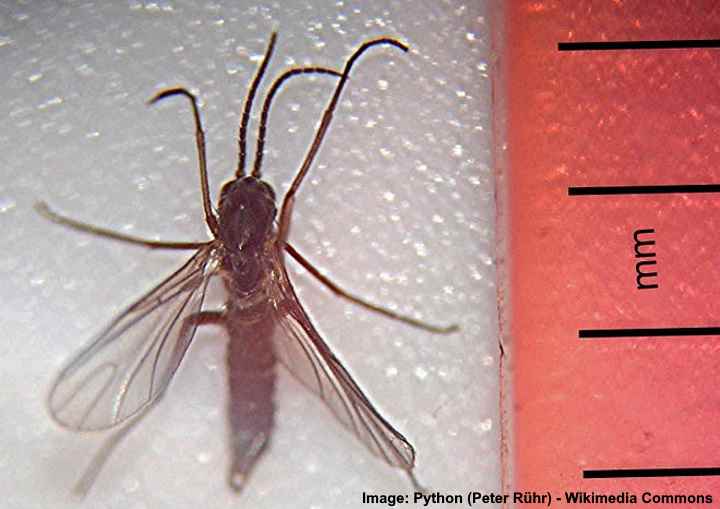
Gants are small black flying bugs that can be found in damp places in the house
Tiny black flying bugs in your kitchen, living room or bedroom could be fungus gnats. The small, winged bugs have a black or dark gray, slender body, six legs, and two long antennae. These tiny bugs only measure 0.08” to 0.3” (2 – 8 mm) long. They become annoying when flying in faces.
Fungus gnats are commonly found in potting soil, damp places, or other sources of organic composition. Even though they are a nuisance and get in your face, fungus gnats don’t bite or sting. And if they infest houseplant soil, they won’t do any lasting damage to plants.
What attracts black fungus gnats to your home? Gnats typically get into your home in potted plant soil. However, factors like dampness, humidity, and light at night can draw the annoying pest to your home. Then the tiny black bugs lay larvae in dark, damp places, and you’ll end up with lots of little flying bugs to deal with.
These black bugs with wings are most active in spring and summer. However, they can be active throughout the year inside your home. This is why it’s so crucial to get rid of fungus gnats for good; otherwise, getting rid of swarms of gnats is exceedingly challenging.
Small Flying Bug Identification
Fungus gnats are easy to identify because they are dark gray or black flies with slender bodies, long legs, antennae, and transparent wings.
How To Get Rid of the Small Flying Bug in the House
To eliminate fungus gnats from potting soil, make a soil drench by mixing one-part hydrogen peroxide 3% and four parts water. Then, use the solution to kill bugs in the potting mix as you water your plants.
You can use sticky yellow traps to reduce their numbers if you have fungus gnats in the kitchen. However, eliminating the source of black gnats is the only way of getting rid of them for good.
Fungus Gnat vs. Fruit Fly

Mexican fruit fly (Anastrepha ludens)
Fungus gnats are easy to confuse with fruit flies. The main differences between the two are their shape and color. Gnats are black with slender bodies and long, dangling legs. On the other hand, fruit flies are brown with a rounded shape, somewhat like tiny houseflies.
Housefly (Musca domestica)
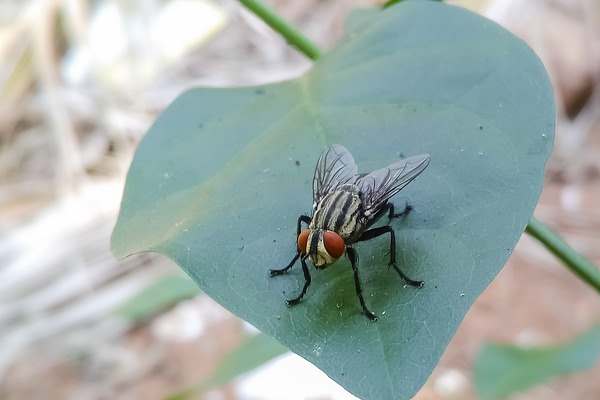
Houseflies are common house flying bugs that can cause infestation in large quantities
The common housefly is a dark gray to black fly with a stripped back and fuzzy appearance. Houseflies measure about 0.2” (6 mm) long. They also have transparent wings and spiny black legs. The small annoying black flies also have two pronounced compound eyes.
Houseflies are a nuisance pest because of the buzzing sounds they make. Also, their erratic flying behavior and excellent vision make them difficult to swat. A serious reason to get rid of houseflies is that they are disease carriers, and they feed on rotten meat and decaying organic matter.
Small Flying Bug Identification
The common housefly is identified by its black body, gray and black striped thorax, and large reddish-brown compound eyes.
How To Get Rid of the Small Flying Bug in the House
The first step to getting rid of houseflies is to remove all potential food sources. So, it’s a good idea to store food in sealed containers or in the refrigerator. Also, keep a tight lid on trash cans and don’t leave pet food out overnight.
Flesh Flies (Sarcophagidae spp.)
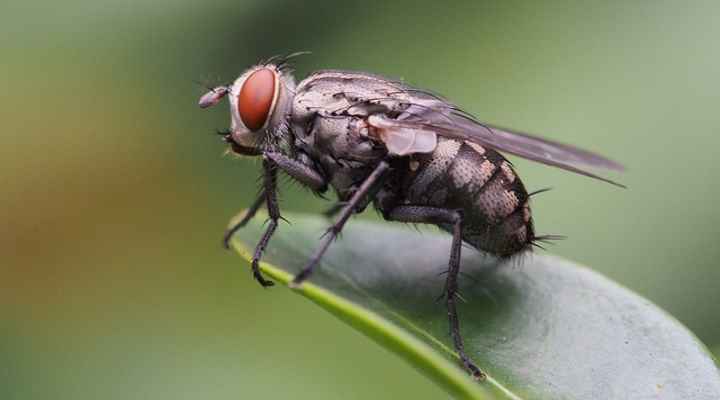
Flesh flies are small flying bugs in the house that are attracted to meat scraps
Flesh flies are another common type of household black flying bug. The tiny flies are slightly larger than houseflies, measuring 0.16” to 0.9” (4 – 22 mm) long. Like houseflies, flesh flies have a black body with gray stripes on the thorax. The flies usually lay eggs on scraps of meat.
Because of their ability to transmit disease and feed on garbage and feces, flesh flies are also classified as filth flies. Therefore, getting rid of flesh flies is just as important as eradicating houseflies from your kitchen.
Small Flying Bug Identification
Flesh flies are identified by their dark gray to black bodies and sometimes have a greenish or bluish metallic sheen. In addition, you may notice stripes or checkered patterns on their back.
Cluster Fly (Pollenia rudis)
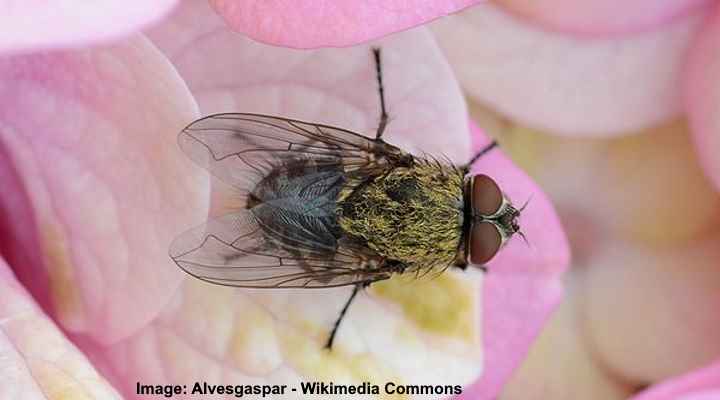
Cluster flies are commonly found in attics and are not attracted by garbage
The common cluster fly is a small blackish flying house bug, identified by its black and brown mottled patterns in its thorax. The small fly has a slightly fuzzy appearance due to tiny hairs near its head. Cluster flies measure around 0.35” to 12” (9 – 12 mm) long.
Cluster flies become a nuisance in the home when they congregate in masses in late summer and early fall. They usually live and breed in inaccessible areas of homes and hibernate until spring. Unlike houseflies, cluster flies aren’t attracted by garbage, dirt, or filth.
Small Flying Bug Identification
To identify a cluster fly, look for its black body with light brownish markings just behind the head. Clusters of flies are often found in attics or lofts — one reason why they are called attic flies.
How To Get Rid of the Small Flying Bug in the House
Cluster flies are difficult to get rid of due to their large numbers. However, you can swat or vacuum flies you find indoors or use flypaper to reduce their numbers. To prevent further infestations, caulk all gaps around vents, electrical outlets, doors, windows, and baseboards.
Small Flying Bugs In The House That Are Not Fruit Flies
Although fruits flies and gnats are common household flies, other flying bugs can become a significant nuisance in homes. For example, some species of flying insects are commonly found in kitchens, whereas others are where you have houseplants.
Drain Fly (Psychodidae spp.)
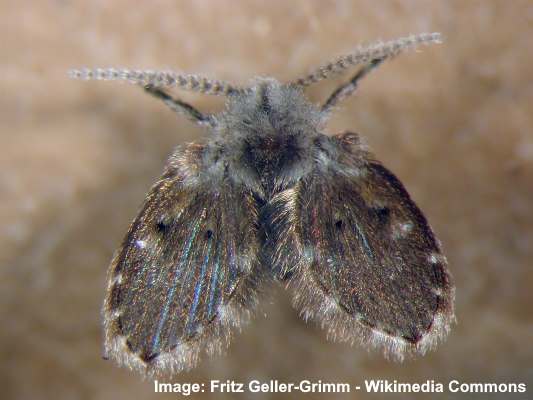
Drain flies are tiny flying house bugs with gray-brown furry look
Drain flies are gray fuzzy flying bugs with broad moth-like hairy wings. The tiny, winged creatures measure around 0.1” (2.5 mm) and usually emerge at night or from dark places like sink drains or tend to hop over kitchen countertops.
As their name suggests, drain flies inhabit drains, breeding and living in slimy filth. Due to their habitat, drain flies also go by the names sewer flies, sewer gnats, and sink flies. Getting rid of them is challenging because their larvae can swim, and the nasty gray bugs hide in drain sludge.
Small Flying Bug Identification
A drain fly is identified as a tiny gray moth-like fly that is often seen hovering around drains, sinks, and sewers.
How To Get Rid of the Small Flying Bug in the House
The best way to eradicate these disgusting flying bugs is to clean your drains thoroughly. Use a baking soda and vinegar remedy to get rid of flies from your drain.
To kill drain flies and larvae, pour a pot of boiling water down the drain. Then put a cup of baking soda in the drain, followed by a large cup of equal parts white vinegar and water. Cover the drain and wait for ten minutes. Lastly, pour a pot of boiling water down the drain to kill flies, white maggots, and larvae.
Blowfly (Calliphoridae spp.)
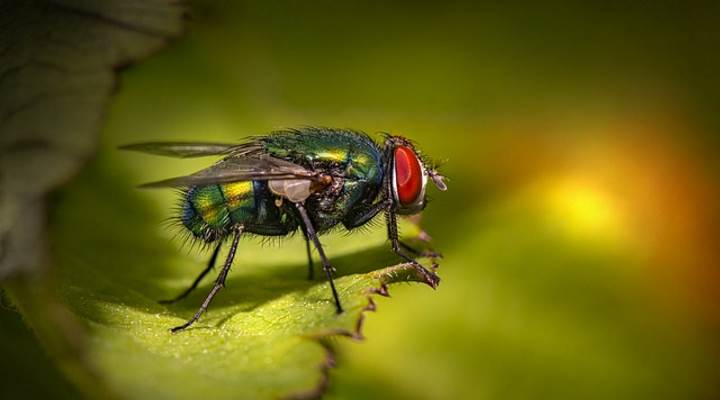
Blowflies are usually shiny metallic in their appearance
A blowfly is a large flying bug that you might find in your kitchen, living room, or garage. The repulsive fly is identified by its metallic blue or green color, black legs, brown wings, and pronounced red compound eyes. Blowflies behave like houseflies, measuring 0.3” to 0.4” (8 – 10 mm) long.
Blowflies are attracted to garbage, rotting organic matter, and trash. Due to their shiny blue or greenish appearance, they are also called bottle flies, bluebottles, or greenbottles. Because they can spread disease and infect food, it is essential to eradicate blow flies from your home.
Small Flying Bug Identification
A blowfly is easy to identify due to its metallic blue or green body, erratic flight behavior, and loud buzzing noises.
How To Get Rid of the Small Flying Bug in the House
The best way to eliminate blowflies is to destroy their food source or breeding ground. Therefore, ensure garbage trash cans have a tightly fitting lid, remove all food from counter tops, and clean any pet waste from your home.
Whitefly
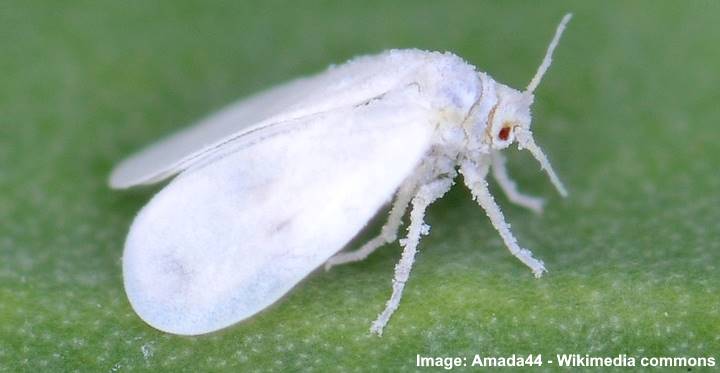
A close up picture of a whitefly. The tiny whitefly is a pest that can usually be found on the underside of the plant’s leaves
Whiteflies are identified as tiny, white-colored flying bugs that fly around infested houseplants. The tiny white flying creatures measure 0.08” (2 mm) long and usually fly in clusters. Although the swarming white bugs don’t bite humans or sting, they cause houseplant damage by biting into plant tissue, weakening the plants, and spreading disease.
Related reading: How to get rid of whiteflies.
Small Flying Bugs in The House
Phorid Fly (Phoridae spp.)
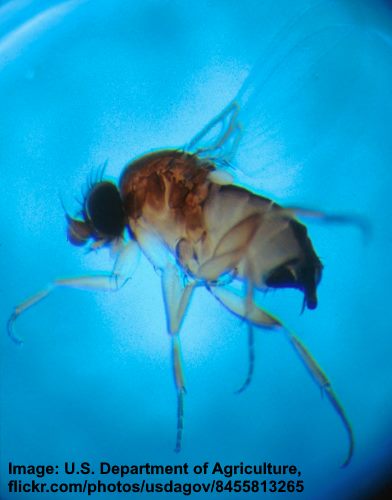
Phorid flies are identified by their humpback and erratic flight
A phorid fly is a tiny brown flying insect that looks like a fruit fly but isn’t a fruit fly. Instead, the minuscule flying bug has a black to yellowish-brown color and an arched thorax. Phorid flies are just as tiny as fruit flies, measuring only 0.12” (3 mm) in size.
It’s easy to tell a phorid fly apart from fruit flies by their flight behavior. Unlike fruit flies that hover or fly in a straight line, phorid flies fly erratically in a zig-zag pattern. It’s vital to get rid of these disgusting bugs because they tend to feed on decaying, rotten organic matter and drain slime.
Small Flying Bug Identification
A phorid fly is identified by its humpbacked appearance, brownish color, and erratic flight behavior.
How To Get Rid of the Small Flying Bug in the House
To eliminate phorid flies from your home, get rid of any decaying food, open trash containers, and clean drains. To reduce phorid fly numbers, you can use sticky traps until they disappear for good.
Fruit Flies (Drosophila spp.)

Fruit flies are tiny brown house bugs that especially like sweet rotten fruit
Fruit flies are the easiest flying household bugs to identify. The tiny yellowish-brown flying bugs measure 0.1” (2.5 mm) long. They are identified by their short legs, tiny wings, large red eyes, and an oval body. However, fruit fly features are so minute that they look like tan-colored dots hovering around fruit or trash cans.
Fruit flies are active in the kitchen in summer through late fall. The tiny flying bugs are attracted by decaying or fermenting food, garbage, and compost piles. Also called vinegar flies or pomace flies, the bugs also feed on soda pop, syrups, and liquor.
Small Flying Bug Identification
A fruit fly is one of the most common flying bugs in kitchens. The small oval fly has a tan body and two large dark red eyes.
How To Get Rid of the Small Flying Bug in the House
Make a DIY trap to eradicate fruit flies from your home. All you need to do is pour apple cider vinegar into a glass, so it’s one-quarter full. Cover with plastic wrap and secure with a rubber band. Then poke a few holes in the plastic and place it on your kitchen countertop.
Alternatively, to kill fruit flies for good, you could use an old banana peel or apple core instead of cider vinegar as bait. The sweet, fermenting aromas will attract the fruit flies and trap them in the jar.
It’s also crucial to keep fruit and vegetables and any sugary items in the refrigerator or suitable sealed container.
Pantry Moths
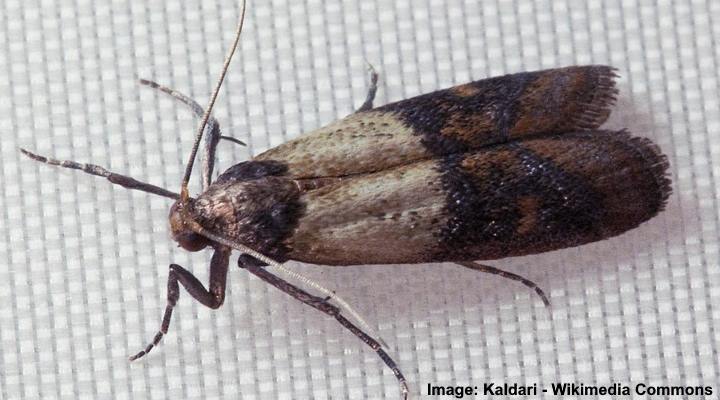
The brown and gray Indianmeal moth is commonly found in kitchens and pantries in grain products
Pantry moths are small flying bugs that infest dried food items like flour, grains, spices, rice, seeds, and nuts. The most common flying kitchen bug is the Indianmeal moth. This common pantry bug is identified by its recognizable reddish-brown patterns covering half of its wings. The flying bugs measure 0.3” to 0.4” (8 – 10 mm) long.
The issue with pantry moths is that they can contaminate cereals and stored foodstuffs. The annoying tiny moths lay eggs, and then larvae hatch in dried food products. Signs of pantry moth bug infestations are silky webs dangling inside food packets, frass (feces that look like tiny black specks), dead skin, and crawling white maggots.
Small Flying Bug Identification
Pantry moths are identified as small fuzzy flying bugs with an elongated oval body and grayish wings, half of which have a mottled reddish-brown pattern.
How To Get Rid of the Small Flying Bug in the House
To get rid of pantry bugs for good, discard any infected food products in a sealed plastic bag. Then thoroughly clean the pantry cupboard and storage areas with hot soapy water. This will kill any microscopic white eggs or tiny white larvae that may be lurking in crevices.
Flying Ants in the House
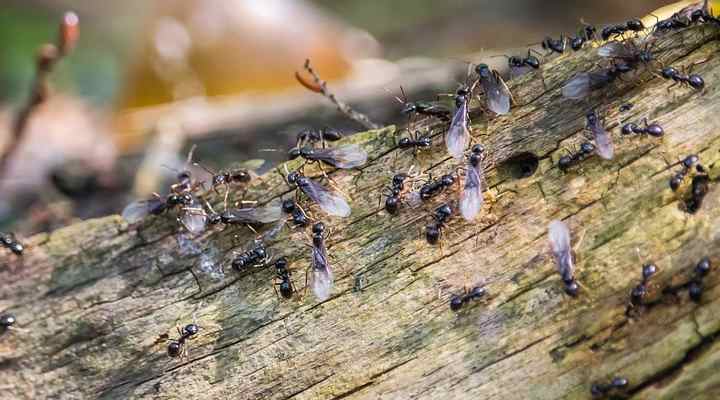
Flying ants can enter your house in spring or summer and are usually attracted to sweet foods
Winged ants are small flying bugs that can be found in houses in late spring and early summer. Some ant species develop wings when they mate and form a new colony. They appear when conditions are right—when it’s warm and humid. The ants swarm outdoors and can fly into houses through open windows and doors.
Flying ants range in size from 0.23” to 0.51” (6 – 13 mm); however, the queen ants can be as large as 0.70” (18 mm) long. Flying ants look like regular ants, only with translucent wings.
Typically, sweet food, fruits, and sugary liquids attract ants to your home. Therefore, the best way to prevent these flying bugs in your home is to keep doors and windows closed when ants typically swarm outdoors.
Small Flying Bug Identification
You can identify a flying ant by its slender body, two sets of wings, and elbowed antennae. Typically, flying ants are black or brown in color. They range in size from 0.23” to 0.70” (6 – 18 mm) long.
It’s easy to confuse flying ants with termites. However, the differences between termites and ants are the body shape, type of antennae, and wing sizes. Unlike termites, ants have thin waists, wings of differing lengths, and bent antennae.
How To Get Rid of the Small Flying Bug in the House
Prevention is the best way to eliminate winged ants from your home. Therefore, seal cracks and crevices and install insect screens on windows and doors.
After forming a colony, flying ants shed their wings. So the best way to get rid of the tiny pesky bugs is to use the same methods for getting rid of regular ants.
Termites (Isoptera) — Small Flying Bugs That Damage Homes
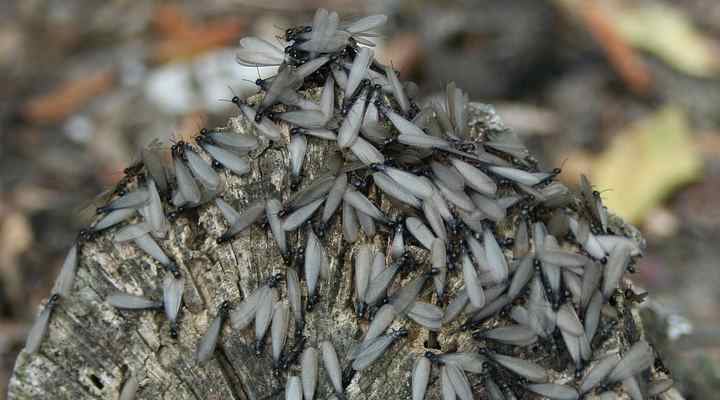
Flying termites can cause a serious damage to wooden structures at homes
Certain species of termites can fly – these are dampwood termites and subterranean termites. Flying termites are generally brown or black, and have a set of long wings. Unlike flying ants, termites have straight antennae. They can measure 0.25” to 0.5” (6 – 13 mm) long.
Termites are a serious problem because they can cause extensive damage to homes. Signs of termite activity in a home include wood that sounds hollow, blistering paint, and tiny holes in drywall. You may also notice that tiles become loose or floorboards buckle.
Therefore, contact a pest control professional immediately if you suspect termites in your home.
Small Flying Bug Identification
Flying termites typically have a brown or black body, a pair of wings of the same length, straight antennae, and a straight waist. Most termites measure up to 0.5” (13 mm) long; however, the queens can be around 1” (25 mm).
How To Get Rid of the Small Flying Bug in the House
Natural methods to get rid of a small number of termites include spraying wooden structures with a neem oil solution, using diatomaceous earth, or putting down boric acid traps.
For example, scientific research suggests that neem oil is an effective termite repellant. Researchers found that spraying or painting wooden surfaces with neem oil could be a “user-friendly and cost-effective” way to prevent a termite attack.
Mosquitoes (Culicidae)

Mosquitoes are bloodsucking insects that can be found buzzing around in bedrooms at night
Mosquitoes are tiny flying disease-carrying pests and are some of the most annoying flying bugs found in homes. Mosquitoes are typically grayish-brown with a recognizable long beak-like sucking mouth part called a proboscis they use to “bite” humans and animals and suck blood. These small and pesky bugs buzz around rooms when it’s dark.
Mosquitoes get into homes by flying in through open windows. Therefore, the best way to prevent them is to keep all windows closed or use insect screens. Additionally, having mosquito nets over beds reduces the risk of mosquitoes biting you while you sleep.
Although not all mosquitoes transmit diseases like malaria, dengue fever, and Zika virus, their bite can leave an irritating itchy bump that lasts several days.
Small Flying Bug Identification
Mosquitoes measure 0.11” to 0.23” (3 – 6 mm) long. They are easily recognizable from other flying bugs because of their slender bodies, long proboscis, and long dangling legs when flying.
How To Get Rid of the Small Flying Bug in the House
Getting rid of mosquitoes from a house is vital because they can spread disease when having a blood meal. Using a natural mosquito repellent that contains citronella or other citrusy aromas can deter the blood-sucking flying insects from choosing you for their next meal.
In addition, mosquitoes are attracted to darkness, humidity, and standing water. Therefore, ensure that there are no leaking pipes under your sink. You can also grow mosquito-repelling plants in your house and yard.
Clothes Moths (Tineola bisselliella)
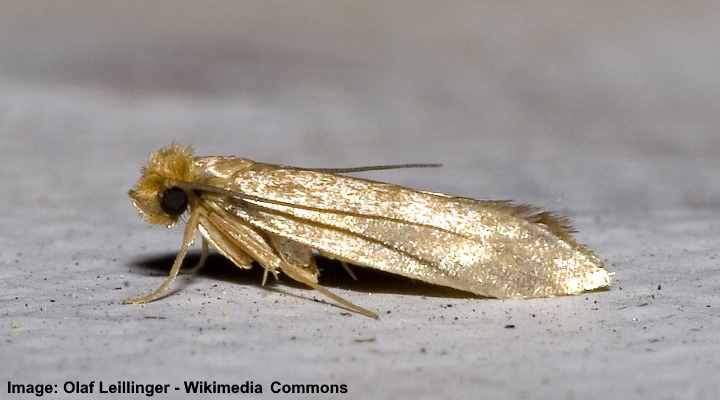
The clothes moth is a little grayish or pale brown bug whose larvae cause damage to natural fabrics
Also called webbing clothes moth or clothing moth, these flying bugs in the house can chew through natural fabrics, leaving holes in clothing. Clothes moths are pale brown to tan and measure 0.24” to 0.28” (6 – 7 mm) long with a wingspan up to 0.63” (16 mm).
The annoying insects are attracted to carpeting or clothing that contains traces of sweat. However, the clothes moth larvae are the creatures that do the most damage. The small white worm-like bugs eat wool, silk, cotton, linen, and even synthetic fibers blended with wool.
Small Flying Bug Identification
Clothes moths are small, beige-colored flying bugs that grow around 0.5” (13 mm). They are identified by their narrow wings that have fine hairs along the margins. It’s easy to mistake these fabric-eating bugs for grain moths. However, they are challenging to spot because they avoid light.
How To Get Rid of the Small Flying Bug in the House
Several ways to rid your closet and clothing of clothes moths involve various methods to kill the bugs. For example, dry cleaning clothing is an effective method of killing moth larvae in clothing. Additionally, you can freeze clothing or wash at a high temperature to destroy the bugs for good.
After killing clothes moths in fabrics and carpets, you must eradicate any remaining larvae in drawers, closets, and from behind baseboards. The best way to kill any remaining eggs and larvae is to vacuum them and dispose of the dust bag in a sealed plastic bag.
Crane Flies (Tipulidae)
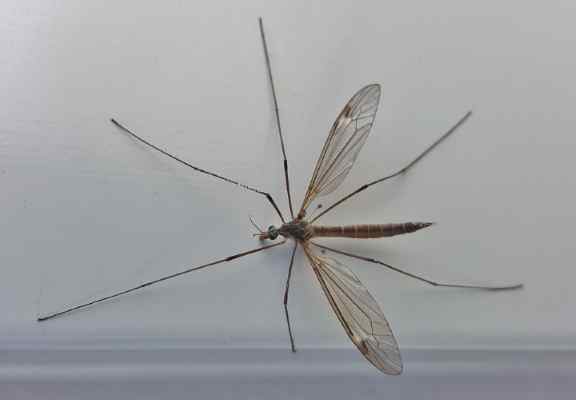
Crane flies can swarm homes and like humid conditions
Despite their benefit to garden ecosystems, crane flies can become irritating pests in the home. Crane flies are easy to recognize due to their long, slender bodies and stilt-like legs, making them look like huge mosquitoes. Typically, crane flies measure 0.5” to 2.5” (10 – 65 mm) long.
Crane flies don’t bite, but they can become a nuisance after rainfall or in humid conditions when they seem to grow in number. In addition, the large flying creatures are attracted to light at night and can swarm into homes when you open a door or window.
Crane flies thrive in damp soil, wet leaves, heavily watered lawns, and tall grasses.
Due to their resemblance to mosquitoes, they are called mosquito hawks, mosquito eaters (although they don’t eat mosquitoes), and daddy longlegs.
Small Flying Bug Identification
Crane flies are easily identifiable due to their slender, pointed abdomen, large wings, V-shaped groove on their thorax, and long spindly legs.
If you see a bug flying in your house that looks like a giant mosquito, it’s likely to be a crane fly.
How To Get Rid of the Small Flying Bug in the House
The best way to get rid of crane flies from your house is to stop them from breeding in your front or backyard.
For example, keep your lawn in good order by mowing it to the proper height, removing thatch, and watering it less frequently. Additionally, you should keep garden debris to a minimum and ensure a compost heap is well away from the house.
You can also attract crane fly predators—birds. Therefore, put out bird feeders or encourage birds to nest in your yard. In time, you should notice a marked difference in the number of crane flies bothering you indoors.
Carpet Beetles
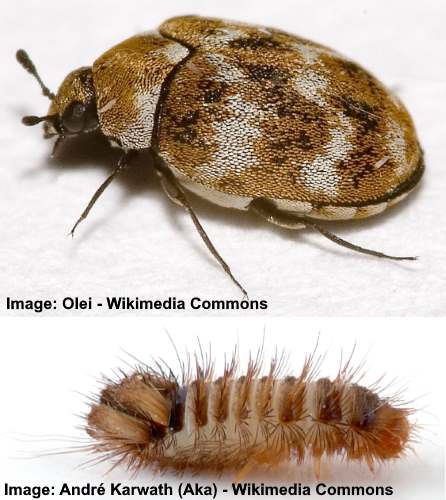
The varied carpet beetle Anthrenus verbasci (top image) and larva (bottom image)
Carpet beetles are small, oval-shaped flying insects measuring between 0.06” to 0.2” (1.5 – 5 mm). They typically have mottled black, brown, and white patterns on their backs. These fabric-eating bugs usually fly into homes through open windows. However, the woolly carpet beetle larvae do all the damage to carpets.
Female carpet beetles lay eggs around the edges of carpets. After the larvae emerge, they go to work, munching on natural fibers and leaving holes in carpets, clothing, and soft furnishings. They also eat feathers, silk, leather, and wool.
Small Flying Bug Identification
Depending on the species, carpet beetles can be black, brown, or have mottled patterns on their wing cases. The tiny larvae are usually white and measure about 0.039” (1 mm), making them impossible to spot in carpets.
How To Get Rid of the Small Flying Bug in the House
The best way to eradicate carpet beetles from your home is to kill the larvae and prevent adults from flying in through windows.
Here are some tips on killing these bugs in your home:
Vacuum regularly: Ensure that carpets and floors are as clean as possible. This prevents the beetle larvae from feeding on dead insects, hair, and skin cells. Also, ensure that the edges of carpets and around baseboards are clean.
Wipe surfaces with a vinegar solution: Use a solution of one part white vinegar and one part water to clean hard surfaces. Also, ensure to clean away any food residue and don’t leave pet food out overnight.
Steam clean fabrics: Hot steam is ideal for killing tiny bug eggs and larvae lurking in soft fabrics or furnishings.
Common Furniture Beetle (Anobium punctatum)

The furniture beetles are small dark brown beetles and their larvae cause damage to timber and to household furniture
Also called the house borer, the common furniture beetle is a destructive flying pest in homes. The winged beetles have an elongated brown oval body with grooves along the wing cases. The small wood-boring beetles measure 0.11” to 0.18” (2.7 – 4.5 mm) long. The larvae grow from 0.039” (1 mm) to 0.28” (7 mm) long.
Like most destructive beetles in the home, larvae cause damage to wooden items like furniture, flooring, and timber construction. The females lay eggs in crevices, and the creamy white larvae spend three to four years chewing through wood without being noticed. The first signs of a furniture beetle infestation are small holes on the wooden surface.
Small Flying Bug Identification
Also called woodworm beetles, furniture beetles have a reddish-brown color and an ellipsoidal body. Their prothorax looks like a monk’s hood. The adult beetles grow up to 0.18” (4.5 mm) long. However, it’s impossible to see the larvae as they spend all their time chewing through cellulose in wood fibers.
How To Get Rid of the Small Flying Bug in the House
Pest control for woodworm beetles is almost impossible because larvae activity goes unnoticed until it’s too late. However, keeping relative humidity in a building below 60 percent could stop furniture beetles from being active.
Biting Midges (Ceratopogonidae)
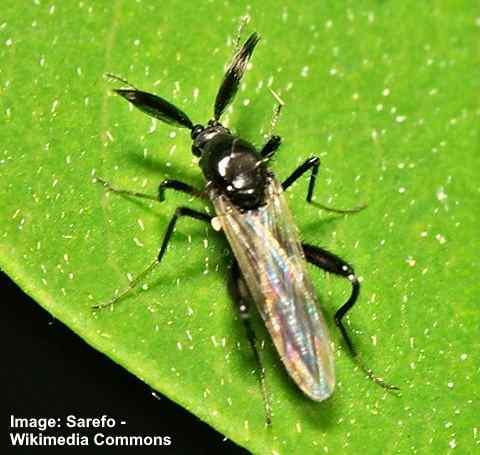
Biting midges are house pests that are attracted to damp environments
Biting midges are tiny flying insects that can be a serious nuisance in homes. The minute flies bite humans and pets. Biting midges fly in swarms, and the pesky flies measure 0.12” (3 mm) long. These tiny, flying, biting pests are active around damp or aquatic environments.
Biting midges can become a nuisance in the home if there is a swimming pool, stream, pond, sand, or marshy ground near your home. Therefore, getting rid of midges usually involves removing any water sources near your home.
Midge bites can result in small, reddish welts that are extremely itchy. Although some midge species carry disease, they only affect livestock, not humans. Other names of the tiny bugs include punkies, sand flies, no-see-ums, five-O’s, and pinyon gnats.
Small Flying Bug Identification
Biting midges are difficult to identify because they are so tiny. However, you will usually notice them as small flies the size of pinpricks hovering in groups.
How To Get Rid of the Small Flying Bug in the House
The best way to rid your home of biting midges is to prevent them from entering through open doors and windows. It is also vital to eliminate any traces of standing water in your yard. And having tightly woven insect screens on windows is useful in areas prone to midge infestations.
You could also try making a DIY midge trap to reduce their numbers. To make a flying insect trap, mix a tablespoon of apple cider vinegar with a few drops of washing-up liquid. Place this in a dish where you think midges are entering your home. The fermented liquid attracts small flies, and they stick to it when they land.
Wasps

Wasps can enter homes especially in summer and inflict a painful sting
Wasps can become pesky annoyances indoors when they are most active in the summer. Or they may venture inside, looking for suitable places to build a nest in the fall. Common areas of homes where wasps can become a severe problem are attics, under the eaves, sidings, or wall cavities.
Wasps are typically black and yellow in color, with a slender, hairless body, narrow waist, two antennae, and six legs. However, wasps can be black and white or mostly brown with dull yellow bands. Wasps usually measure 0.3” to 0.5” (8.4 – 13 mm) long. But some larger wasps and hornets can be as large as 1” (25 mm) long.
The danger of wasps flying around your home is their ability to sting. Wasps can use their stinger to sting multiple times and be aggressive when provoked. In some cases, you must call professional pest exterminators to remove a large wasp nest near or on your property.
Small Flying Bug Identification
Wasps are easy to identify due to their slender, three-segmented bodies with a head, thorax, and abdomen constricted waist. The most common wasps, like yellowjackets, have black and yellow bands across their abdomens.
Further reading: Types of Wasps and How to Identify Them.
How To Get Rid of the Small Flying Bug in the House
Like most bugs that fly into the house, preventing wasps from entering your home is the best advice. If you have already sealed cracks and crevices to prevent other flying pests from getting indoors, you will rarely have wasps inside.
If wasps make a nuisance flying around the yard, you can use a wasp trap. All you need to do is take a large soda bottle and cut off the top. Next, fill the bottom of the bottle with a few inches of fruit juice or soda or fruit juice, plus a few drops of dish liquid. Invert and replace the top to create a funnel. The sugar liquid will attract the wasps, and they won’t be able to escape.
Related articles:
- Types of Kitchen Bugs – Identification
- Common Types of Small House Bugs
- Small Black Bugs – Identification
